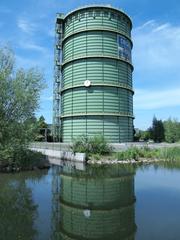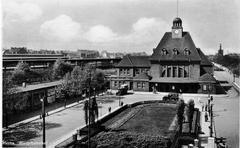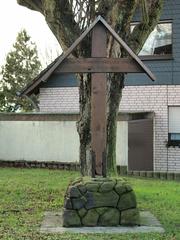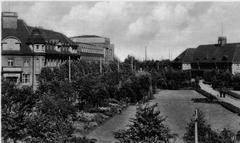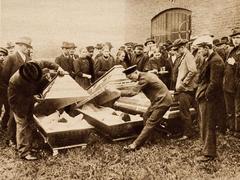Zeche Pluto Visiting Hours, Tickets and Guide to Herne Historical Site
Date: 04/07/2025
Introduction to Zeche Pluto: History and Cultural Significance
Located in the heart of the Ruhrgebiet, Zeche Pluto in Herne stands as a symbol of Germany’s industrial legacy and its contemporary cultural transformation. Founded in 1854 and named after Pluto, the Roman god of the underworld, the former coal mine seamlessly blends historical architecture, natural reclamation, and community activity. Once a key player in the region’s industrialization, Zeche Pluto has reinvented itself as a vibrant cultural and recreational landmark. Today, it reflects the Ruhrgebiet’s journey from a center of heavy industry to a destination for heritage tourism, ecological renewal, and social remembrance (Zeche Pluto Visiting Hours, Tickets, and History | Herne Historical Site Guide; Zeche Pluto Herne: Visiting Hours, Tickets, and Cultural Significance).
Visitors can admire the iconic Doppelstrebengerüst headframe, explore the Halde Pluto-Wilhelm—a reclaimed slag heap transformed into a nature reserve—and take part in guided tours, cultural events, and educational programs. With excellent access via public transit, free entry to outdoor sites, and its inclusion in the renowned Route der Industriekultur, Zeche Pluto attracts history enthusiasts, families, hikers, and photographers. As a living monument, it honors the Ruhrgebiet’s working-class heritage and promotes sustainability through innovative post-mining land use (Halde Pluto-Wilhelm Visiting Hours, Tickets, and Things to Do in Ruhrgebiet; Visiting Zeche Pluto in Herne: Hours, Tickets, History & What to See).
This guide covers Zeche Pluto’s historical evolution, cultural value, detailed visitor information, accessibility, and highlights in the surrounding area. Whether you want to delve into industrial history, enjoy natural beauty, or participate in cultural programming, Zeche Pluto offers a rich and layered experience.
Quick Contents Overview
- The Significance of Zeche Pluto
- Historical Development
- Founding and Naming
- Expansion and Technical Progress
- Role in Regional Industrialization
- Innovations and Challenges
- By-products and Infrastructure
- Closure and Post-Mining Projects
- Cultural and Social Impact
- Visiting Information
- Opening Hours
- Tickets and Guided Tours
- Getting There and Parking
- Accessibility
- Visitor Tips
- Special Events and Offers
- Frequently Asked Questions (FAQ)
- Halde Pluto-Wilhelm: Ecology and Visitor Info
- Opening Hours and Admission
- Directions and Parking
- Accessibility
- Nature Experience
- Leisure Activities
- Cultural Significance
- Visitor Tips
- FAQ
- Main Attractions and Visitor Experience
- Nearby Sights
- Summary and Call to Action
Entdecken Sie die Zeche Pluto: Historische Einblicke und Besuchsinformationen
Überblick und Bedeutung
Die Zeche Pluto, heute ein Industriedenkmal in Herne-Wanne, ist ein bedeutender Bestandteil der industriellen Vergangenheit des Ruhrgebiets. Neben Einblicken in den Steinkohlebergbau bietet das Gelände heute attraktive Erholungsmöglichkeiten und kulturelle Angebote.
Historische Entwicklung
Gründung und Namensgebung:
Gegründet 1854 als „Zeche St. Nicolaus“, wurde sie 1859 nach Pluto, dem Gott der Unterwelt, benannt – ein Symbol für die Bergmannsarbeit unter Tage.
Ausbau und technische Entwicklung:
Der erste Schacht „Thies“ entstand 1857, „Wilhelm“ folgte 1873. Insgesamt wurden sieben Schächte angelegt, begünstigt durch die Nähe zu Bahn und Kanal.
Bedeutung für die Region:
Als Gründungsmitglied wichtiger Kohlesyndikate prägte die Zeche Pluto die Industrialisierung und war ein zentraler Arbeitgeber.
Innovation und Herausforderungen:
Trotz Problemen wie Schlagwetterexplosionen setzte die Zeche auf Innovation, z.B. das heute denkmalgeschützte Doppelstrebengerüst von Fritz Schupp.
Nebenprodukte und Nachbergbau:
Ab 1891 wurde Sole gefördert, die das Thermalbad „Wilhelmsquelle“ versorgte. Die Halden Pluto-Wilhelm und Pluto-Thies sind heute grüne Naherholungsgebiete.
Stilllegung und Transformation:
1976 wurde der Bergbau eingestellt. Das Gelände dient heute nachhaltigen Nachbergbauprojekten und beherbergt ein modernes Grubenwasser-Management.
Kulturelle Bedeutung:
Das Stadtteilzentrum Pluto bietet vielfältige Freizeit- und Kulturangebote. Die Route der Industriekultur vernetzt Zeche und Halden mit anderen Landmarken.
Besuchsinformationen zur Zeche Pluto
Öffnungszeiten
- Das Außengelände und die Halden sind jederzeit frei zugänglich.
- Stadtteilzentrum Pluto:
- Montag–Freitag: 9:00–18:00 Uhr
- Samstag: 10:00–16:00 Uhr
- Sonntag: geschlossen
- Führungen und Veranstaltungen haben abweichende Zeiten.
Tickets und Führungen
- Der Zugang zu Außenanlagen ist kostenlos.
- Für Führungen und Veranstaltungen ist eine Anmeldung erforderlich. Tickets und Termine finden Sie auf der offiziellen Website des Stadtteilzentrums Pluto und bei der Route der Industriekultur.
Anfahrt und Parken
- ÖPNV: Bahnhof Wanne-Eickel (ca. 15 Gehminuten), mehrere Buslinien.
- Auto: Parkplätze am Stadtteilzentrum und in der Umgebung.
Barrierefreiheit
- Das Stadtteilzentrum ist barrierefrei. Die Haldenwege sind größtenteils befestigt, können aber für Rollstuhlfahrer Einschränkungen aufweisen.
Besuchertipps
- Wetterfeste Kleidung und festes Schuhwerk empfohlen.
- Fotomotive am Wilhelmschacht und auf der Halde nutzen.
- Besuchen Sie auch andere Ziele der Route der Industriekultur.
Besondere Veranstaltungen und Angebote
- Regelmäßige Führungen, Kulturveranstaltungen und Ausstellungen im Stadtteilzentrum Pluto.
- Details online auf den Seiten des Stadtteilzentrums und der Stadt Herne.
FAQ – Zeche Pluto
Wann kann ich die Zeche Pluto besuchen?
Das Gelände ist jederzeit zugänglich; das Stadtteilzentrum hat feste Öffnungszeiten.
Gibt es Eintrittspreise?
Außenanlagen sind kostenfrei, Führungen/Veranstaltungen ggf. kostenpflichtig.
Wie komme ich mit ÖPNV hin?
Bahnhof Wanne-Eickel zu Fuß, Buslinien in der Nähe.
Ist die Anlage barrierefrei?
Stadtteilzentrum ja, Halden nur eingeschränkt.
Kann ich fotografieren?
Ja, das Gelände eignet sich hervorragend für Fotos.
Gibt es gastronomische Angebote?
Gelegentlich im Stadtteilzentrum, sonst in der Umgebung.
Nützliche Links
- Stadtteilzentrum Pluto Herne
- Route der Industriekultur – Halde Pluto
- RAG Nachbergbau und Grubenwasserhaltung
- Tourismus Herne – Offizielle Seite
Zeche Pluto Herne: Cultural Revival and Visitor Experience
Transformation to a Cultural Symbol
Zeche Pluto’s evolution from a major coal mine to a cultural and ecological landmark mirrors the Ruhr’s broader shift. The Halde Pluto-Wilhelm, established as a nature reserve in 2005, is a prime example of industrial land rewilding (NRW Tourist), turning a slag heap into a habitat for rare flora and fauna. The 75-meter-high Halde Pluto, with its five-meter-high observation platform, provides sweeping views and a setting for remembrance and community activities (Ruhr Tourismus).
Community, Memory, and Accessibility
For generations, Zeche Pluto was the heart of Herne-Wanne’s working-class community. Today, it remains a key point of collective memory, with year-round free access to outdoor areas and a platform reached via a 40-step stairway (NRW Tourist). The site’s design encourages physical activity and inclusivity, though some areas have limited accessibility for visitors with mobility challenges.
Practical Visitor Information
- Visiting Hours: Year-round, dawn to dusk; no tickets required.
- Location: Herne, North Rhine-Westphalia; accessible by car, bus, and bicycle.
- Facilities: Walking trails, panoramic platforms, and interpretive signs.
Educational Value
Zeche Pluto offers interpretive displays and guided tours, connecting mining history with ecological restoration. It is a key node in the Route der Industriekultur, linking to other industrial heritage sites (Ruhrgebiet Industriekultur).
Urban Ecology and Regeneration
The transformation of the slag heap into the Naturschutzgebiet Bergehalde Pluto-Wilhelm demonstrates the Ruhr’s urban ecological vision (NRW Tourist). The area supports biodiversity and invites visitors to reflect on the relationship between industry and nature.
Regional Tourism and Economic Impact
Zeche Pluto enhances Herne’s profile as a tourist destination, complementing attractions like Schloss Strünkede and the Cranger Kirmes (The Crazy Tourist). Its free access and inclusion in tourism campaigns support economic diversification.
Arts and Working-Class Heritage
The industrial landscape inspires artists and serves as the subject of documentaries and public art. Memorials and oral history projects ensure the stories of miners, including those from immigrant backgrounds, are preserved (Herne Damals Heute).
Integration into Heritage Networks
As a member of the Route der Industriekultur, Zeche Pluto is connected to significant sites across the Ruhr and Europe (The Crazy Tourist).
FAQ – Zeche Pluto (EN)
What are the visiting hours?
Daily, dawn to dusk, year-round.
Is there an admission fee?
No, outdoor areas are free.
How do I get there?
Easily accessible by car and public transport; parking available.
Is it accessible?
Nature reserve paths are accessible; the platform requires climbing steps.
Are there guided tours?
Yes, periodically; check local tourist information.
Halde Pluto-Wilhelm: Landscape, Ecology, and Practical Visitor Info
The Halde Pluto-Wilhelm demonstrates the Ruhr’s conversion of former industrial terrain into green, recreational spaces (RVR).
Opening Hours and Admission
- Open year-round, no admission fees.
Directions and Parking
- Car: Parking near the former colliery and residential areas; 30–45 min walk to the summit (Ruhrpottblick).
- Public Transport: Bus stops in Gelsenkirchen-Bismarck or Herne-Wanne.
- Bicycle: Connected via the Erzbahntrasse cycling route (warumichradfahre.blog).
Accessibility
Most paths are well maintained, but the final ascent and stairs are not fully wheelchair accessible.
Nature and Ecology
The 12.3-hectare nature reserve supports diverse flora and fauna, with meadows and pioneer plants. It is part of the region’s biotope network.
Recreation
Popular for walking, cycling, and nature observation. The plateau offers panoramic views and is a favorite for photography—especially during the August Cranger Kirmes fireworks (Ruhrpottblick).
Cultural and Historical Significance
As part of the Route der Industriekultur, the Halde and nearby colliery relics demonstrate the Ruhr’s mining legacy.
Practical Tips
- Wear sturdy shoes; paths can be steep and rocky.
- No toilets on the Halde; facilities nearby.
- Stay on marked trails to protect wildlife; dogs must be leashed.
- Best visits: spring, summer, or during Cranger Kirmes.
FAQ – Halde Pluto-Wilhelm
Is there an entry fee?
No, access is free.
Are dogs allowed?
Yes, on a leash.
Are there public toilets?
Not on the Halde; available nearby.
Is it barrier-free?
Some sections are not suitable for wheelchairs.
How do I get there by public transport?
Multiple bus lines serve nearby stops—use local travel apps for updates.
Why Visit Zeche Pluto?
Zeche Pluto offers an immersive industrial heritage experience. Its Doppelstrebengerüst headframe, preserved mining buildings, and proximity to the scenic Halde Pluto observation platform appeal to history buffs, architecture fans, and outdoor enthusiasts alike.
Opening Hours and Tickets
- Outdoor areas: freely accessible year-round.
- Guided tours and events: see official websites for dates and ticket information.
Getting There and Accessibility
- By car: Parking available.
- By public transport: Bus stop “Zeche Pluto” nearby.
- Accessibility: Some terrain and the observation platform involve stairs.
Highlights
- Doppelstrebengerüst headframe
- Historic mining buildings
- Halde Pluto-Wilhelm with panoramic views
- Part of the Route der Industriekultur
Events and Guided Tours
- Extraschicht Festival: Annual night of industrial culture.
- Themed guided tours: Offered by local heritage groups.
Facilities
During events, amenities and refreshments may be available. Additional services in Herne center.
FAQs
Is there an entry fee?
Generally free during public events; some tours require a fee.
Is the site family-friendly?
Yes, especially during events and for outdoor exploration.
Nearby Attractions
- Mondpalast Folk Theater
- LWL Museum
- Other industrial heritage sites: Zeche Teutoburgia, Zeche Consol
Summary and Recommendations
Zeche Pluto stands as a testament to the Ruhrgebiet’s successful transition from coal mining to cultural and ecological innovation. It offers visitors a blend of historical insight, natural recreation, and cultural programming, all accessible free of charge in the outdoor areas (Zeche Pluto Visiting Hours, Tickets, and History | Herne Historical Site Guide; Zeche Pluto Herne: Visiting Hours, Tickets, and Cultural Significance). Integration into the Route der Industriekultur, ongoing post-mining projects, and frequent events make Zeche Pluto a year-round draw for a wide audience (Halde Pluto-Wilhelm Visiting Hours, Tickets, and Things to Do in Ruhrgebiet; Visiting Zeche Pluto in Herne: Hours, Tickets, History & What to See).
Plan your visit, explore the remarkable industrial and natural sites, and enjoy the unique spirit of the Ruhrgebiet! For guided tours and audio content, download the Audiala app and follow local heritage platforms.
References and Useful Links
- Zeche Pluto Visiting Hours, Tickets, and History | Herne Historical Site Guide
- Zeche Pluto Herne: Visiting Hours, Tickets, and Cultural Significance
- Halde Pluto-Wilhelm Visiting Hours, Tickets, and Things to Do in Ruhrgebiet: Ecology, Recreation, and History
- Visiting Zeche Pluto in Herne: Hours, Tickets, History & What to See
- Herne Damals Heute
- NRW Tourist
- Ruhr Tourismus
- Ruhrgebiet Industriekultur
- Ruhrpottblick
- warumichradfahre.blog
- The Crazy Tourist
